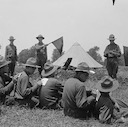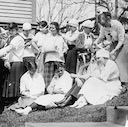Designed to be flexible, Eagle Eye Citizen can fit into a variety of components within a lesson plan. The following pages outline different ways you can teach with the site as a lesson hook, independent practice, or guided practice. To assign a challenge to your students to solve, save the link of the challenge and share it through your classroom management system, write it on the board, or provide a handout.



Solving a challenge makes for a great lesson hook either to introduce a new content area to students or to introduce analyzing primary sources in a low-stakes context.
Students can take a Time After Time challenge on voting or women’s suffrage before beginning a lesson on voting rights and learn that the campaign to expand voting rights often occurred over a decades-long period.
Students might also be introduced to a particular kind of primary source by completing a challenge featuring those sources. For example, students could learn how to analyze posters by completing a Big Picture challenge featuring a WPA poster.
Students can also solve and create challenges as independent practice to build content area knowledge and skills.
Have students solve three challenges related to civil rights and then as a class have students share which challenges they have solved, how they interpreted the sources, and what they learned about the topic.
Students can also build primary source analysis skills through solving and creating challenges. For example, have students create a Sort It Out challenge on a topic of their choosing. When they are finished they can share with the class what sources they chose and why they chose them.
You can also choose to guide a class through solving and creating challenges to reinforce important points about a topic or emphasize specific observation and reflection skills.
For example, at the end of each challenge is a brief overview or "Bird's Eye View" of the topic of the challenge. You can use these as a review or introduction to a topics such as Voting, Freedom of Religion, Political Parties, Slavery, Civil Rights, or Civic Duty.
At the same time, you can read the Bird's Eye View as a class to introduce a lesson after the class has completed a challenge or as preparation for future challenges on the same topic.